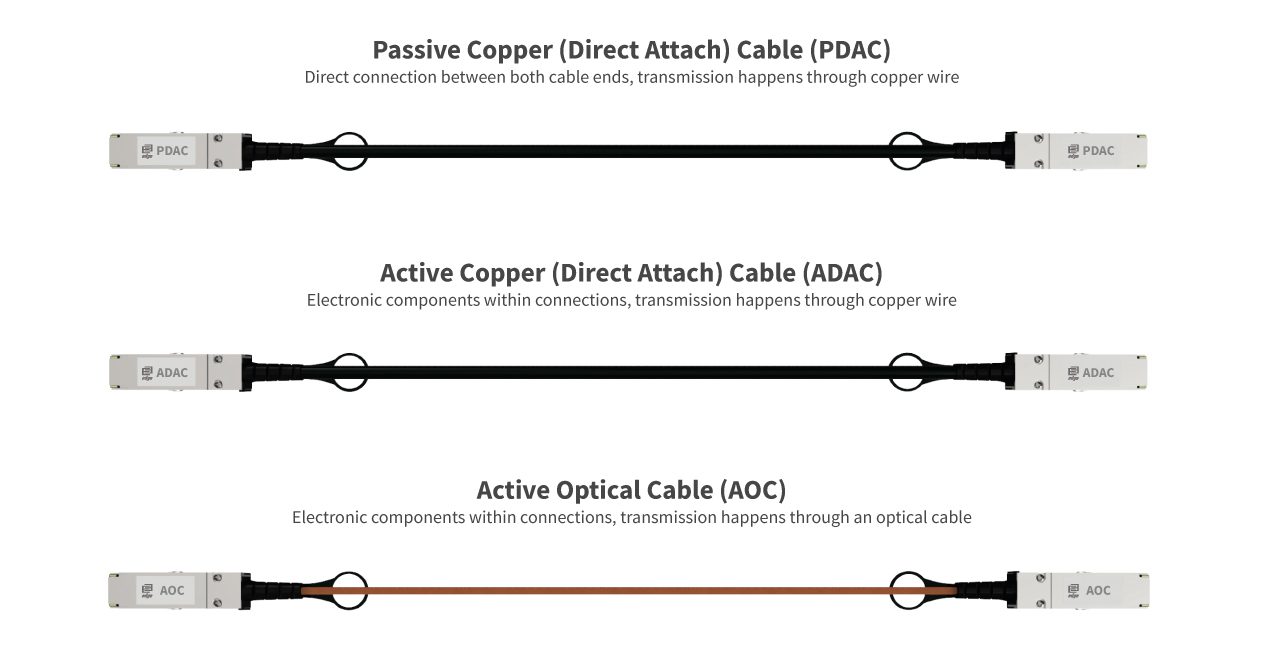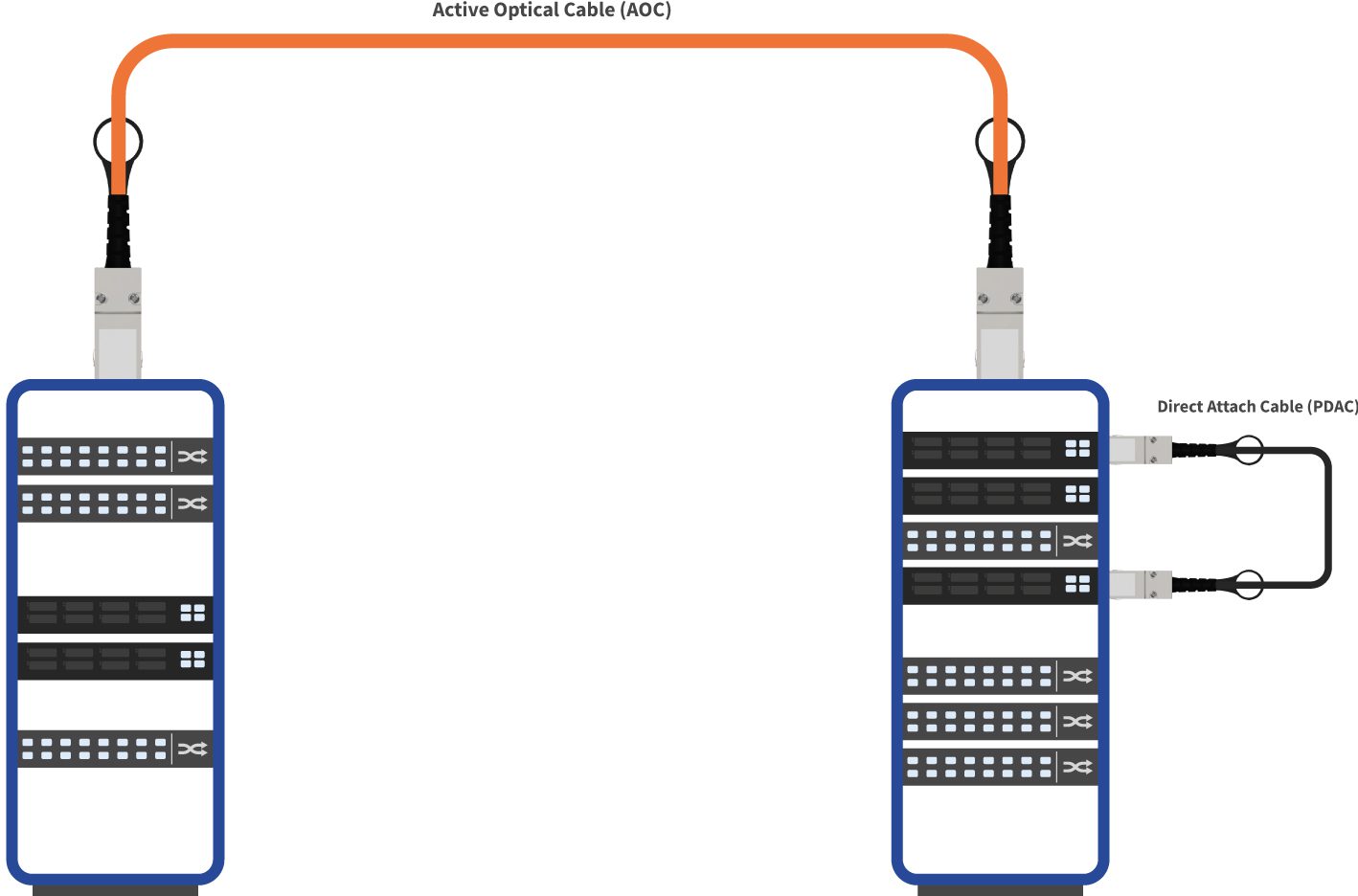With the development of technology, the demand for data transmission speed has become more urgent. In this context, 10G to 400G active (AOC) and passive (DAC) cables have become the key link to connect high-speed data centers. This article will explore the different characteristics and advantages of these two cables and their applicable scenarios in practical applications.
Directory
- Introduction
- DAC vs Optical transceivers
- Breakout cables
- Cable Form Factors
- DAC & AOC use cases
- What we can offer!
Introduction on Passive and Active cables
Direct Attach Copper passive cable or a DAC cable is a twinax copper cable that connects directly the ports (or line cards) within active equipment, such as switches, routers, servers or data storage devices, in a data network. In simple terms, a DAC has transceiver modules at either end of a 24-28 AWG (American Wire Gauge) passive copper cable that allows direct communication between devices over copper wire. Both ends have welded on specific transceivers and the cable length is fixed. Electromagnetic shielding around the copper cable increases as the speeds increase to keep communication reliable. DAC cables offer a very cost efficient and easy way of making various network connections, that’s why they are becoming so popular today within data centers and beyond in other areas of the industry.
However, despite how popular they are with the crowd there are some drawbacks to the DAC cables. For example, you can’t somehow change or edit their length since these cables come already with modules installed in them and because of that they come in a fixed length so you must know for sure what you are looking for when purchasing these cables.
Let’s have a look at the different types of DAC cables. There are 3 common DAC cable types:
- Passive DAC cables
- Active DAC cables
- Active Optical cables
Passive DAC cables have minimal power consumption (<0.15w) since they don’t contain any electrical components. However, their range is limited to only 7m, so for something longer you’ll probably need an
Active DAC cable which does contain electrical components which boosts its signal levels, thanks to which it has greater reach of distance, starting from 5m and beyond. Another benefit to Active DAC cables is the ensured improvement of transmission quality, but because of the containing electrical components these cables are also a little bit more expensive and more energy consuming than their Passive counterpart.
Active Optical cables are similarly built as DAC cables, but instead of Copper transmission medium, optical fiber is used. Optical transceiver transmitting and receiving components are fixated to optical fiber without option to remove or replace the optical fiber. So similarly as with DAC cables you have to choose correctly the distance required. AOC cables are chosen because of their ability to reach far more distance than compared to classical DAC. As a benefit using AOC also can be mentioned the lack of electromagnetic interference which does not influence the Active Optical cable. But does bring signal interference in between DAC cable connections. AOC cables are also usually lighter then same length DAC cables.
DAC vs Optical transceivers
As a transmission medium in nowadays datacenter connection DAC cables or Optical transceivers can be used. What really is the difference? Let’s find out!
The 10G DAC is connected to two switches through copper cables. But the optical transceivers which are plugged in switches are connected with optical patch cable. For the DAC cable – 10G is short-distance transmission; the longest distance possible is 10 meters. But on the contrary the SFP+ transceiver can perform long-distance transmission. With Optical transceivers you can do up to 120 km through Single-Mode fiber. The 10G DAC is a copper cable designed with SFP+ connectors on both ends and is less expensive than a 10G optical transceiver. The use of 10G DAC wiring is more flexible, transmission distance up to 15 meters, in the actual construction process is less difficult to operate.
10G DAC cabling saves on connected devices, eliminating the need for patch panels, and servers and network equipment can be directly connected to TOR switches, which indirectly save on input costs.
Breakout cables
Breakout mode on network equipment (switches, routers, and servers) opens up new ways for network operators. The breakout mode is when a high-speed port is broken down to multiple lower speed ports. For example, a 40G transceiver embedded on one side of the passive cable, where on the other side of the cable there are 4 independent 10G transceivers. The mode is always implemented in multilane form factors, such as QSFP+, QSFP28, QSFP56, QSFP-DD. Such form factors as SFP+ and SFP28 do not have the possibility to break out to lower data rates. You can find the Breakout cables that we can provide just below this article.
Cable Form Factors
In today’s market you can find cables with various data rates, ranging from 10G up to 400G. To ensure the data rate, all cable transceivers differ in their form factors:
- SFP+ (Small Form-Factor Pluggable) is used for data rates up to 10Gbps. SFP+ is an updated version from an SFP, but both do not differ in a visual appearance. A standard SFP typically has a longer transmission distance, but SFP+ specifications are based on the SFF-8431 standard. In terms of SFP vs SFP+ compatibility, SFP+ ports often accept SFP optics but at a reduced speed of 1Gbps.
- SFP28 also known as Small Form-Factor Pluggable 28 has the same appearance as an SFP or SFP+, but this specific form factor is designed for 25G performance per the IEEE 802.3by specification. SFP28 copper cable has significantly greater bandwidth and lower loss when compared to the SFP+ version.
- QSFP+ form factor (Quad Small Form-factor Pluggable) can replace 4 standard SFP+ transceivers, which results in greater port density and overall system cost savings. QSFP+ supports four independent 10G lanes, which allows for 4x10G cables and stackable networking designs that achieve better throughput.
- QSFP28 is a Quad Small Form-factor Pluggable 28. When describing SFP28, we mentioned that it is designed specifically for a 25G connection. The QSFP28 provides 4 independent 25G channel lanes, in other words, providing us with the possibility of 100G applications.
- QSFP56 also known as Quad 50 Gigabits Small Form-factor Pluggable is the form factor to provide a 200Gbps link. QSFP56 denotes 4 x 50 to 56Gb/s in a QSFP form. Sometimes it can also be referred to as 200G QSFP for the sake of simplicity.
- QSFP-DD (Quad Small Form Pluggable Double Density) form factor is the IEEE802.3bs and MSA standard compliant. In short, it doubles the number of interfaces that the standard QSFP28 form factor supports. The QSFP-DD not just offers a path to 200G but also creates a cost-effective path to scale to 400G.
DAC & AOC use cases
From our experience DAC passive cables are more used than any other type of cables, but network engineers as well use AOC cables for their applications. So there comes a question: when to use which cable type?
Direct Attach cables are mostly used for connections inside racks, respectively connections between switches, servers and storage inside racks. On other hand, Active Optical cables are mostly used to link switches, servers, and storage between different racks inside data centers. Not only the cables differ whether electrical or optical signal is transmitted, but also from the perspective of costs, connection distance and power consumption. Passive DAC cables operate in distances up to 7 meters (active DACs can operate up to 10 meters), while AOC cables can do up to even 100 meters. Speaking about the costs of both types, copper cables have simple internal structure with fewer components, hence they are much cheaper than fiber cables. The power consumption of AOC cables is higher than DACs. Respectively, AOC has an approximately 1-2W power consumption, while DAC has approximately 0.15W.












